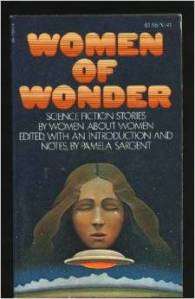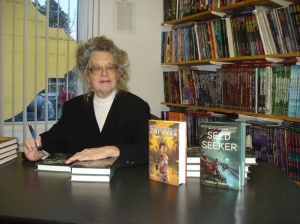Lately I have found myself in a reading rut, that is I am not doing very much of it at all! I come in from work and after all my household tasks have been completed I can barely muster the energy to flop in front of the TV, or even live vicariously through the Sims 3. As for reading a book, well, forget it! One or two pages is all I can manage before I conk out and now I am six books behind on my Goodreads Challenge. What is a disenchanted reader to do?
The answer came from that old saying which is often used to make short people (like myself) feel better about being unable to reach the top shelves; good things come in small packages. In this case, it was short stories to the rescue. I have never been much of a short story reader, preferring the deeper level of detail and emotional investment which comes from novels. However the time had come for short stories to take centre stage, and become the main vehicle for all my fiction reading.
The collection I selected was Women of Wonder: Science Fiction Stories by Women about Women. It was published way back in 1975 as a mass-market paperback. Women of Wonder is made up of twelve stories and one poem by science fiction (sci-fi from here on in) writers who are all women, and who use women as the protagonist in their stories.
Before the stories begin readers are treated to an essay by Pamela Sargent on the history of women in the world of science fiction. This was absolutely fascinating to read especially now forty years after it was first published. Sargent’s detailing of women’s involvement in science fiction as writers was really interesting. She takes us from Mary Shelley, a women of whom it can be argued was the first science fiction writer ever, to the women writing in the 1960s and 1970s. It will make many fans happy to know that the numbers were ever growing as time marched on, and the stories became more innovative with diverse subject matter. Through this essay I came to learn the names of many women writers and Sargent presents arguments for why their work so valuable in the world of sci-fi. Sargent takes no prisoners in her tacking of attitudes and opinions of male science fiction critics and authors to women authors and characters. There was plenty of cheering and despairing face-palming moments in this essay and it was amusing to see how little some things have changed – for the good and bad – in the past 40 years. For any fans of sci-fi history Sargent’s piece is a must read and it definitely added to my own knowledge and understanding, and to my to-read list!
As for the stories themselves, there is a diverse mix of themes and ideas present for readers to enjoy. Some stories are based on earth, others are on alien planets. Some have main characters who are human while others are aliens or machines (or both!). Even though the stories were written 40-50 years ago, they felt fresh and I would have been unable to accurately guess when they had been written. There is a story in this collection for everyone, so to help you find it I have summarised them all below, trying to be as spoiler free as possible.
The Child Dreams (1975) by Sonya Dorman
The first piece of creative writing to be featured is a poem which sets the mood for the coming stories. It is explosive with dreams of space and liberation from kitchens and hero princes.
That Only a Mother (1948) by Judith Merril
An eerie, creepy story in the sub-genre (if I have no idea if this is a sub-genre, but it should be) of maternity sci-fi. The story explores a world damaged by atomic weaponry and how the resulting pollution damaged pregnancies, babies and mothers. I have read quite a few stories which tackled these themes and I quite liked the way Merril lets the readers into a secret that is hidden to her main character.
Contagion (1950) by Katherine MacLean
This story is set in the classic sci-fi arena of interplanetary exploration. These things never seem to end well, and would you expect this story to be any different? While reading I was gripped, waiting for the twist, for things to go wrong. Ultimately this story is one about identity and the need to preserve one’s individuality in the face of uniformity.
The Wind People (1959) by Marion Zimmer Bradley
This is another story which began with interplanetary exploration. This time a woman’s sacrifice takes centre stage as Zimmer Bradley tells the tale of a mother and son left stranded on an alien planet. Sargent describes it as “haunting” I agree that readers can feel the loneliness and anxiety for the future as they age and no ships come back to rescue them. I now feel quite uncomfortable about this story after learning about abuse allegations levelled against Zimmer Bradley. It gives this story a much darker interpretation and has left me feeling really uneasy about it.
The Ship Who Sang (1961) by Anne McCaffrey
This story was fantastic and it absolutely gripped me emotionally. The is a story of a cyborg named Helva. Helva was a spaceship but her thoughts and emotions were definitely human. McCaffrey takes the reader through Helva’s life from her birth in a human body, to her being installed into a new mechanical form, and then on to her early space career. We are with her as she forms bonds and learns to love to sing. By the end of the story I became quite attached to Helva and I would love to have read more of her adventures.
When I Was Miss Dow (1966) by Sonya Dorman
If you have ever wondered what aliens would think if they came down to have a look at humanity, then this story is for you. Dorman tells the tale of an alien allocated a female body and sent to work to gather resources for her family. This story has quite a lot of elements to it, the sacrificing of education for paying work, the fear of the “other” and how women are treated in human, and alien, societies.
The Food Farm (1967) by Kit Reed
This was one of my favourite stories in the book. It centres on a teenage girl who is experiencing many issues that teenage girls, both now and in the past, can relate to; issues with food, body confidence, obsession with gorgeous celebrities and parents who do more harm than good because of their misguided good intentions. But this is fiction, and Reed takes teenage angst and warps them through a sci-fi lens, creating a tale that is both liberating and deeply unnerving.
Baby, You Were Great (1967) by Kate Wilhelm
I would love to ask Wilhelm what she thinks of TV today, the likes of Big Brother and Keeping Up with the Kardashians, which transmit details of people’s personal triumphs and tragedies to the world. This story may have been written in the 1960s but it could have been penned today. Wilhelm examines the idea of people being directly wired into to their entertainment programmes so that they can experience the emotions of the people on screen. It is a great idea and is excellently explored by Wilhelm.
Sex &/or Mr. Morrison (1967) by Carol Emshwiller
This is a strange little story so I will give the final word to the author. “It would be nice to live in a society where the genitals were really considered Beauty. It seems to me any other way of seeing is obscene.” So there you go.
Vaster Than Empires & More Slow (1971) by Ursula K. Le Guin
Here is a story by the grand-dame of sci-fi, the woman who needs no introduction, Ursula K. Le Guin. This story is another example of interplanetary exploration, and unlike the other adventures in this collection it deals with the dangers of alien plant life. I really enjoyed the levels of interpersonal tension between the characters. Cooped up in a spaceship for months, even years, on end would most certainly fray tolerance and patience, and I am glad Le Guin shaped her story around this type of conflict. Few write stories better than Le Guin, her imagination seems to have no limits, and this story is no exception.
False Dawn (1972) by Chelsea Quinn Yarbro
Quinn Yarbro’s story should find a whole new audience in 2015 as it is a story about a strong woman surviving in a post-apocalyptic world. It is bleak and violent, the world reminded me of Fallout New Vegas quite a lot. We follow Thea as she fights to stay alive. She may be biologically adapted to the harsh environment but she has to survive the most dangerous predators of all – other human beings. Trigger warning for sexual violence.
Nobody’s Home (1972) by Joanna Russ
This story is the complete opposite to that written by Quinn Yarbro. Russ writes of a world of plentiful resources and great levels of freedom and equality. Humans gallivant around the world with an instantaneous system of transport; breakfast in New York, lunch in Johannesburg and dinner in Moscow anyone? If everything is so wonderful what could Russ have to write about you may wonder? Even in a Utopia there are problems so have a read and discover what her take is on what it means to live in an almost perfect world.
Of Mist, & Grass, & Sand (1973) by Vonda N. McIntyre
This story had a completely different feeling to all of the others. Set in a world of sand and heat, McIntyre tells the story of a healer Snake in her attempts to treat a sick boy. She does this through her team of snakes as each one possesses a particular talent. When they are brought together they have the power to treat disease and sickness. The atmosphere in this story is powerful and intense, as the readers are drawn into the dark tent where Snake works to save the boy. The sadness of the conclusion is really memorable, and it reminded me of how people who do not understand something can lash out at it in fear, leading to its destruction. This can even if it is the thing which is helping them the most.
Please let me know in the comments below what you thought of the stories. Also if you have any other recommendations for similar books please feel free to add them below too. I hope you enjoy the book.
Women of Wonder is available in paperback through sellers on Amazon.
Please note the some links in this post are Amazon Affiliate links. When you buy something through these links, I receive a commission that helps support this site. Thank you!


